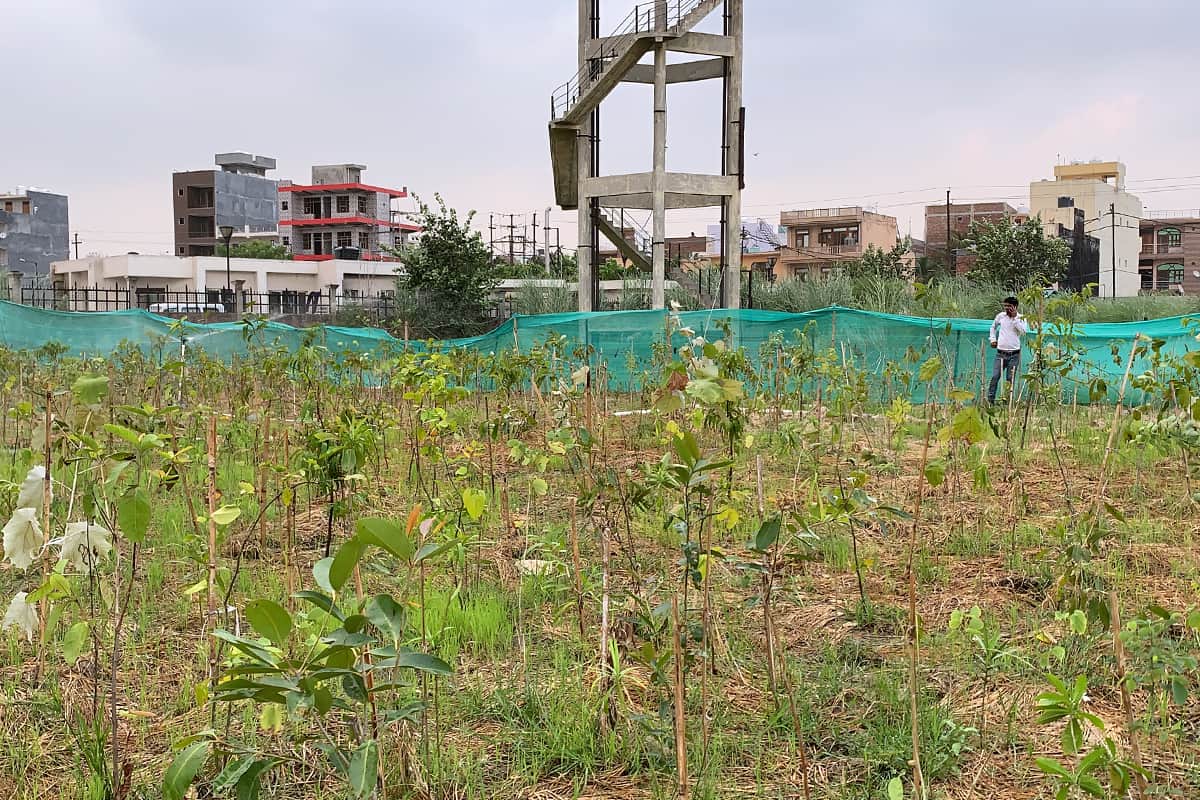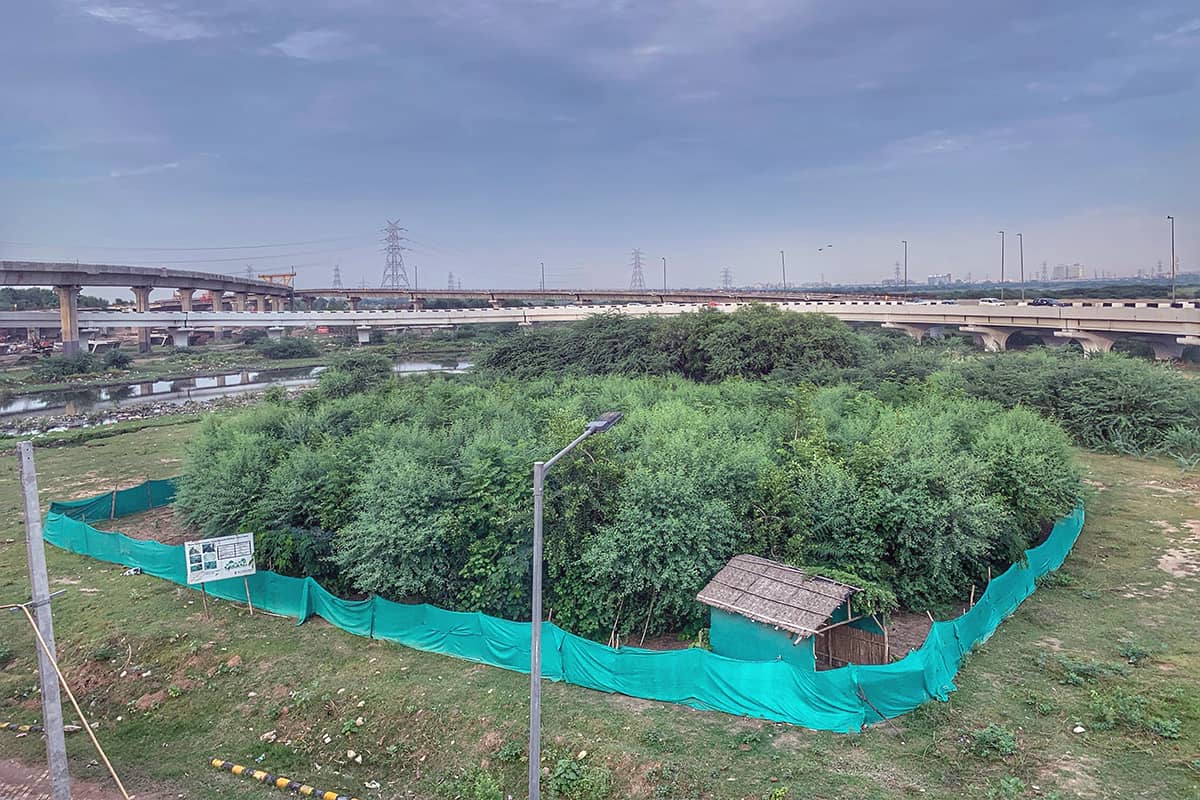In the far past, afforestation was largely a means to generate income from timber and other products. Today, it is integral to our survival.
Loss in green cover and increased concretisation in urban areas has led to cities becoming ‘urban heat islands’, which pose significant threats to not just human populations but also contribute to global climate change. In countries like India that are highly vulnerable to climate breakdown, forests are an integral element towards mitigation.
Tree cover of almost 1.6 million hectares was lost between 2001 and 2018 in India – nearly four times the geographical area of Goa – according to a study released by the World Resources Institute. In its pledge to the UNFCC, the Indian government promised to cover 33 percent of its geographical area with forest cover by 2022, which currently stands at 24 percent.
One possible method to achieve the target would be the Miyawaki method of afforestation. Also called the Potted Seedling Method, this afforestation technique uses native species to create dense, multilayered forests. Akira Miyawaki, the earliest-known pioneer of this system, used potential natural vegetation (the species that would exist at a given location if not impacted by human activities), phytosociology (ways in which plant species interact with each other) and a four-layered system of planting, to design his own system for planting forests.
In the face of a climate breakdown, Miyawaki forests are a “welcome addition to the environment,” said Tarun Gopalakrishnan, Centre for Science and Environment. Planting dense forests with indigenous species, a central tenant in Miyawaki method, is “more suited to building sustainable long-standing forests which set up a kind of equilibrium, and these ecosystems are the best at sequestrating carbon for a climate challenge,” he added.
Planting solo trees like oak, which have become known through popular knowledge, is not the same as planting a forest, explained Sheeba Sen, CEO of Alaap. “These trees behave differently as compared to trees in a dense forest. Like rural kids and urban kids who’ve had different starting points in life and then behave differently.”
Miyawaki forests lower temperature, make soil nutritious, support local wildlife and sequestrate carbon. The idea is to mimic nature while creating these tiny cross-sections of forests, added Sen.

Miyawaki method, also called the Potted Seedling Method, is an afforestation technique that uses native species to create dense, multilayered forests. Photo: Arnold Joyce
Miyawaki in India
In India, this method is slowly gaining momentum. The social enterprise Afforestt has worked with various companies and individuals to create these forests. Recently, they worked with the Department of Biotechnology (DBT), Government of India (GOI) to convert a sewage-ridden patch of land near the Barapullah drain.
This was part of a bigger project named Local Treatment of Urban Sewage Streams for Healthy Reuse (LOTUS HR) to clean the drain. LOTUS is a joint initiative of DBT, Ministry of Science and Technology, and the GOI that set up a demonstration plant to clean up the Barapullah drain. Early site inspections were done in January 2018, and the foundation of the forest laid in July 2018.
Afforestt’s Miyawaki technique includes a six-step process that starts with surveying the soil to assess physical texture, organic carbon, soil pH and more. Then a survey of native species and biomass is done by visiting and collecting relevant data from the nearest natural forest in the region. After this, native saplings are procured and planted in layers, as per Miyawaki guidelines. Finally, the site is monitored and maintained for a period of two to three years, after which the sites become self-sustainable.

The 750 square metre Miyawaki forest at Barapullah site with 2278 trees, which includes 44 native species of trees. Photo: Afforestt
“Roughly costing Rs 50,000 to Rs 60,000 to create a tiny forest of 300 ft and 100 square metre, this method guarantees a high survival and growth rate compared to conventional forests, if the technique is followed to the T,” said Sunny Verma, Executive Director, Afforestt.
Shailja Gupta, Principal Scientist at DBT, looks at this method as a “terrific option in cities where land and space are a constraint. Allowing maximum optimisation of land, the results are very rewarding with a visible increase in growth to nearly 10 ft of over 2000 species that were planted, and of which almost all are thriving,” she said.
Though the potential native vegetation survey is the most critical part of forest creation, Gupta explained that its beauty lies in the close proximity of saplings (minimum of three saplings per square metre) which allows the root systems to remain connected with each other, to help in their upkeep of immunity so that no fertiliser or pesticide is required to keep them healthy and growing. It also helps ward off diseases, added Gupta.
The Noida District Magistrate, B N Singh, who is also keen on the Miyawaki method, has found a rather unconventional way of ensuring afforestation. He said that over the years migration into the city has put pressure on resources such as land, water and others. Government land is being captured for unauthorised construction, selling, buying etc.
As an initiative to utilise available land and increase green cover in the city, he proposed a Memorandum of Understanding (MoU) between local bodies and private and public companies that are ready to invest funds through CSR or otherwise. These partnerships allow the respective parties involved to use the land for the sole purpose of afforestation for a stated period of time, without any other rights or ownership.
In their newest variation of MoU, the district administration of Gautam Budh Nagar signed an MoU with Samsung India to develop a Miyawaki forest in a land area of 71,000 sq mt in the Dadri area, around 35 km from the company’s Noida manufacturing plant. This has been signed under the firm’s corporate social responsibility (CSR) initiative. The district administration has given the land to Samsung India for 10 years towards afforestation.
“By connecting organisations through MoUs and creating forests, it will have a demonstrative impact as well. Now once the forest grows in the Collectorate office, it might motivate others to do this as well,” said Singh.
Singh added, “Once developed, this would be the largest Miyawaki forest in India. Hope some good patches of dense forest will be visible in the district in coming years.”

8500 saplings were planted in 3000 square metre area at the collectorate compound, Noida, in August 2019. Photo: Arnold Joyce.
The way forward for an expensive method
The issue though, with this method, is that its cost can be high. Given that urban land is usually in a degraded state, the cost of preparing the soil and land may be high. Second, these are dense plantations. So the number of saplings needed increases, thereby raising costs.
Alaap’s Sheeba Sen admits to the current cost issues, and added, “Cost issue is a valid thing because the supply chain of the nurseries is not set. Answering to the sudden demand, the cost per sapling has gone up to over Rs 100 per sapling, increasing the total cost immensely.”
Amritha Ballal, urban architect and founding partner at the integrated design firm Space Matters, said that government’s push towards promoting the supply of saplings of native species at their nurseries and using that in afforestation within the city would help boost biodiversity.
“The paradigm shift is from just planting trees to creating a forest. It will take some time to say that the results are also 30 times better. If your costs are more, the results should be worth much more in comparison. We have to empower people and make them feel confident about their investment in plantations which will come through transparency and effective use of technology,” said Sen.
Prem Parivartan, fondly known as Peebal Baba, claims to be one of the earliest champions of Miyawaki system in India. He remembers his first initiative in Patiala not receiving a positive response from farmers and others involved. This was mainly due to the intensive methodology and the costs that came with it.
Though his journey with Miyawaki ended years ago, he believes this to be one of the best methods of forest creation in India. He said, “If a mandate comes into action giving every district a target to create XX amount of forests, in a couple of years we’ll see a huge difference in our society. But this requires political will.”
Going forward, creating Miyawaki forests can’t be looked at as a solution in isolation, but a small significant part of mitigating the effects of climate change. “There needs to be a shift from plantation for ornamental landscapes to creating biodiverse native habitats in private as well as public projects. Not just for fighting heat island effects, but also for groundwater recharge,” said Ballal.
As DBT’s Shailja Gupta said, “For government organisations to find funds through non tendering systems is always a challenge. So I’d want more public sector organisations like ONGC and others that have CSR to adopt little spaces and create Miyawaki forests. Going forward if the public and private sector join in, and this becomes a citizen movement, it will help.”
[This story was first published on Mongabay, and has been republished with minor edits. The original article can be found here.]
